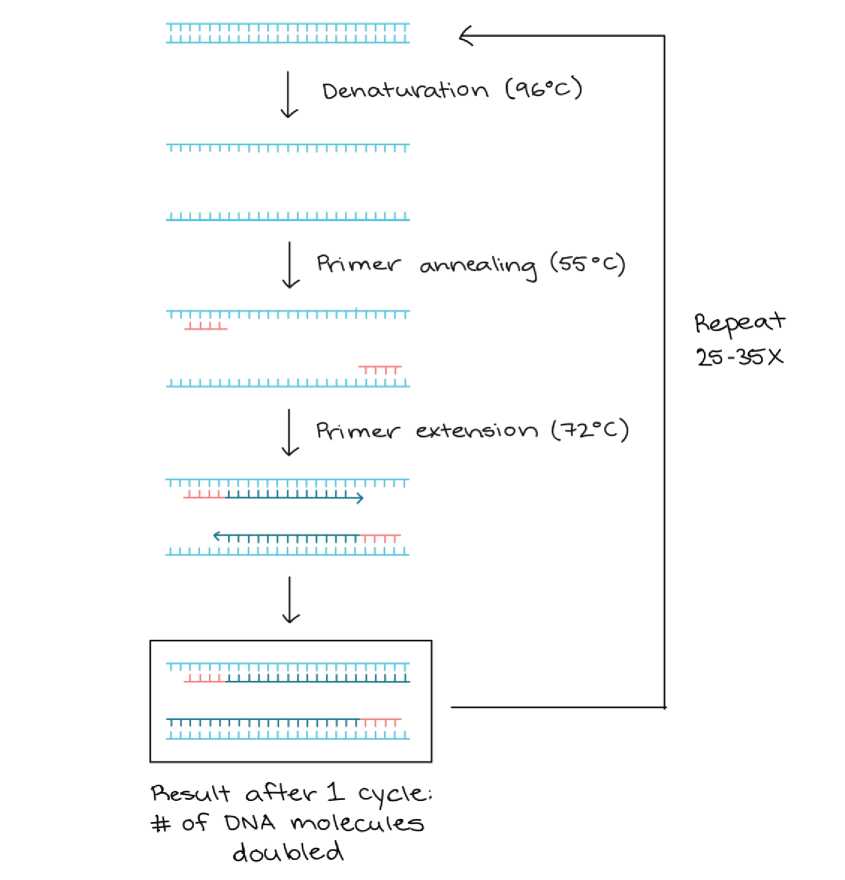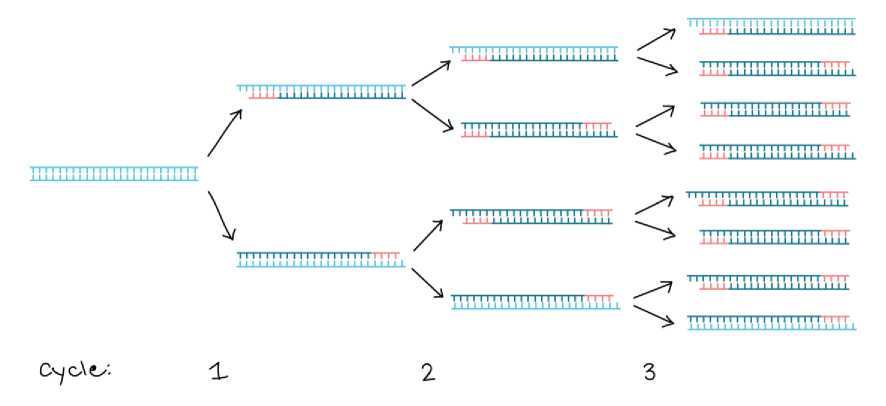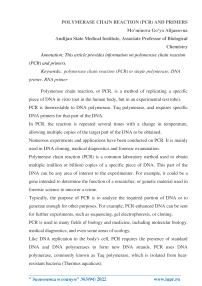Polymerase chain reaction (PCR) and primers
Автор: Mominova G.A.
Журнал: Экономика и социум @ekonomika-socium
Рубрика: Основной раздел
Статья в выпуске: 3-2 (94), 2022 года.
Бесплатный доступ
This article provides information on polymerase chain reaction (PCR) and primers.
Polymerase chain reaction (pcr) to single polymerase, dna primer, rna primer
Короткий адрес: https://sciup.org/140291402
IDR: 140291402
Текст научной статьи Polymerase chain reaction (PCR) and primers
Polymerase chain reaction, or PCR, is a method of replicating a specific piece of DNA in vitro (not in the human body, but in an experimental test tube). PCR is thermostable to DNA polymerase, Taq polymerase, and requires specific DNA primers for that part of the DNA.
In PCR, the reaction is repeated several times with a change in temperature, allowing multiple copies of the target part of the DNA to be obtained.
Numerous experiments and applications have been conducted on PCR. It is mainly used in DNA cloning, medical diagnostics and forensic examination.
Polymerase chain reaction (PCR) is a common laboratory method used to obtain multiple (million or billion) copies of a specific piece of DNA. This part of the DNA can be any area of interest to the experimenter. For example, it could be a gene intended to determine the function of a researcher, or genetic material used in forensic science to uncover a crime.
Typically, the purpose of PCR is to analyze the required portion of DNA or to generate enough for other purposes. For example, PCR-enhanced DNA can be sent for further experiments, such as sequencing, gel electrophoresis, or cloning.
PCR is used in many fields of biology and medicine, including molecular biology, medical diagnostics, and even some areas of ecology.
Like DNA replication in the body's cell, PCR requires the presence of standard DNA and DNA polymerases to form new DNA strands. PCR uses DNA polymerase, commonly known as Taq polymerase, which is isolated from heatresistant bacteria (Thermus aquaticus).
T. aquaticus lives in hot springs and hydrothermal vents. Its DNA polymerase is very heat-resistant and is most active around 70 ° \ text C70 ° C70, °, start text, C, end text (at this temperature human or E. coli DNA polymerase is in a nonfunctional state). This temperature-resistant Taq polymerase is very suitable for PCR. As we can see, in PCR, high temperatures are repeatedly used to denature the standard DNA or to separate its strands.
PCR primers
Like other DNA polymerases, single polymerase can initiate DNA synthesis only in the presence of a short nucleotide sequence, i.e., primers. In PCR reactions, the experimental primer identifies the part of the DNA that needs to be copied or replicated.
PCR primers are short single-stranded DNA fragments, typically 20,020 nucleotides. Each PCR reaction uses two primers, which are adapted to attach to the target (to be copied) part from the sides. In this case, the sequence of primers is connected to the opposite strand of the standard DNA, that is, to the edge of the part to be copied. Primers are attached to the template by a complementary base pair.
TempkoAre
DMA тттттттттттттттттттттттттттттттттттттттттттттттттт PnmexS Ь'^Л +о Лол^рАс^е, ' ..................................................

DNA template:
5ʼTATSAGATSSATGGAGT...GAGTASTAGTSSTATGAGT 5ʼ 3ʼ
ATAGTSTAGGTASSTSA...STSATGATSAGGATASTSA 5' primer 1: 5ʼSAGATSSATGG 5ʼ primer 2:
Once the primers are attached to the template, they are elongated by the polymerases and a copy of the part between them is created.
PCR lines. The main components of the PCR reaction are single polymerase, primers, standard DNA, and nucleotides (DNA building blocks). Together with the cofactors required for the enzyme, the above are collected in a single test tube, which is then put into a high-and low-temperature cycle, resulting in the synthesis of DNA.

The main stages:
-
1. Denaturation (96 ° \ text C96 ° C96, °, start text, C, end text): The reaction is given a high temperature to denature or separate the DNA strands. The result is a one-chain template for the next step.
-
2. Softening (555555 - 656565 ° \ text C ° C °, start text, C, end text): The temperature of the reaction is reduced so that the primers bind to the complementary components in the standard DNA.
-
3. Prolongation (72 ° \ text C72 ° C72, °, start text, C, end text): The temperature rises in the reaction to allow single polymerase primers to lengthen and synthesize new DNA trands.
This cycle is repeated 252,525 to 353,535 times in a normal PCR reaction, with a total time of 222 to 444 hours, depending on the part of the DNA being replicated. If the reaction is effective, the target area can increase several to a billion times.
This is because in each reaction, not only the original DNA serves as a template, but also the newly synthesized DNA in one reaction becomes the template in the next reaction. The reaction contains a large number of primers and Taq polymerase molecules, which can double the number of DNA molecules in each reaction cycle. This exponential growth rate is illustrated in the figure below.

Gel electrophoresis is used to visually check the PCR results
The results of the PCR reaction are usually analyzed visually using gel electrophoresis. Gel electrophoresis is a method in which DNA fragments are passed through an electric current through a gel matrix and separated by size. Typically, standard or DNA sequences are used to determine the size of the fragments in a PCR sample.
Список литературы Polymerase chain reaction (PCR) and primers
- https://uz.khanacademy.org/science/biology/biotech-dna-technology/dna-sequencing-pcr-electrophoresis/a/polymerase-chain-reaction-pcr.
- Muminova Guyokhon,*, Isroilov Rajabboy, Inoyatova Feruza, Abdullaeva Mashkhura. Brain Morphological Changes in the Experimental Hypothyroidism Correction.International Journal of Virology and Molecular Biology. 2021, 10(1): 1-4. http://article.sapub.org/10.5923.j.ijvmb.20211001.01.html.
- Bokiyev M.M, Buzrukova S.U. The importance of horseradish in cute and bronchial asthma. "Экономика и социум". 2021.- №12(91) часть 2.-С.
- Muminova Guyokhon Alijonovna. The role of biogenic factors in the development of allergic reactions. "Экономика и социум". 2021.- №2(81) часть 1.-С. 239-241.


